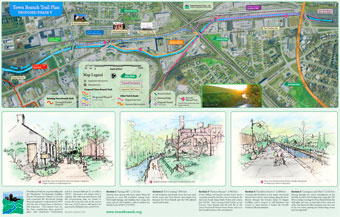Arena just a small part of ideas for all of downtown
By Beverly Fortune — bfortune@herald-leader.com
At a public meeting Wednesday, a consultant unveiled ambitious preliminary ideas for reinventing Rupp Arena and the surrounding area in downtown Lexington.
Architect and urban planner Gary Bates, hired by the city’s Arena, Arts & Entertainment Task Force, proposed a route tying the University of Kentucky campus more closely to downtown, and a continuous commons area — a central park connecting public spaces from Cox Street to the East End.
Bates told the audience in the Lexington Children’s Theatre auditorium on West Short Street that the ideas are only a beginning. He said his urban-design team wanted community input before making final recommendations to the task force at the end of January about the future of Rupp Arena, the Lexington Center and a proposed arts-and-entertainment area.
The 47-member Arena, Arts & Entertainment Task Force was appointed by Mayor Jim Gray in March. The group is being financed with $350,000 in private donations. Bates is one of three founders of SpaceGroup, a 12-year-old architecture and urban planning firm in Oslo, Norway.
Ideas that Bates proposed Wednesday night included:
• A commons area running through the public spaces of downtown, specifically along Vine Street, that would include green space, trees and sitting areas. It would have water features to mimic Lexington’s Town Branch creek, which now is encased in a tunnel buried a century ago underneath Vine Street. There would still be room for traffic on Vine.
• A Cat Walk, basically a procession route from the UK campus to Rupp Arena that would go fromEuclid Avenue down South Limestone to Maxwell Street; then west on Maxwell to the High Street parking lot in front of the Lexington Center. The Cat Walk would cut through the parking lot to the arena.
The route would have its own identity, Bates said, possibly with its own lighting and graphics, such as blue paint or giant cat pawprints on the street. This would tie the campus more closely to the arena, a request of the UK athletics department.
• A new purpose for the sprawling High Street parking lot in front of the Lexington Center. The area could include a Fayette County public school for the arts, an outdoor amphitheatre and sports fields that could be used for parking when needed.
• Preserving and finding a new use for the historic First Baptist Church on West Main Street.
• Looking at new ways to use Victorian Square.
• Developing the proposed Distillery District, on the west side of the Lexington Center, with arts venues, music clubs and restaurants.
• “Reskinning” the exterior of Rupp Arena with a translucent covering and changing the interior to expand lower-arena seating, add backs to upper-arena seats, and boost the fan experience with technology, such as an electronic ribbon around the arena and a drop-down scoreboard above the center of the floor.
• Building a new Lexington convention center, perhaps to the west of Rupp Arena into the Cox Street parking lot, and having it resemble a movie studio lot with several buildings linked by glass covered walkways.
• Moving the retail shops now inside the Lexington Center to street level along West Main Street. When there are no events in the Lexington Center, there is no business for the stores, he said.
• Developing a new transportation hub near the Corman Railroad yard to include a Lexington Transit Authority downtown transfer station, a bike path and a depot for a new passenger rail line.
Reactions from people who heard the ideas were mixed.
Lexington architect Jeffrey Stivers said he heard “a lot of really good ideas. I think people are approaching these ideas with an open mind and are having a healthy discussion. That is very positive.”
But Mike Stutland, owner of Artique in the Lexington Center, questioned the feasibility of the vision.
“I love big dreams, but I’m a realist,” Stutland said. “What I see has bigger costs for executing these ideas than our state has resources or a desire to do.”
Construction on the last expansion of the Lexington Center in the early 2000s hurt his business, Stutland said. “I want to see realistic ways these ideas — like moving retail to street level — can be accomplished without putting me out of business.”
Mayor Jim Gray said a committee of the Arena, Arts & Entertainment Task Force has started working on financing. “First we have to determine the scope of the project and get estimates of cost. Then you go into the question of funding,” he said.
Reach Beverly Fortune at (859) 231-3251 or 1-800-950-6397, Ext. 3251.

